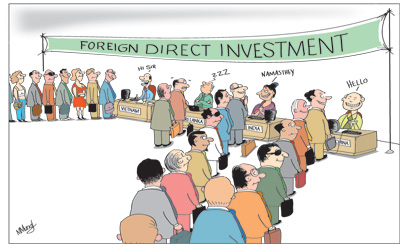Columns
Higher FDI imperative for economic development
View(s):Much higher amounts of foreign direct investment of the right types are needed to propel the economy to higher sustained economic growth and further structural transformation of the economy. This is widely recognised internationally, as well as by most economists in the country, business leaders and analysts.
 The new Investment Promotion Minister, Lakshman Yapa Abeywardene, who was till recently Deputy Minister of Economic Development, has stated quite categorically that Sri Lanka will not be able to achieve an economic development rate of 8 per cent without foreign direct investments amounting to 3 billion US dollars. This is about threefold the amount of FDI that the country received last year. We may add that these FDIs should preferably be in export-oriented manufactures and high-tech industry.
The new Investment Promotion Minister, Lakshman Yapa Abeywardene, who was till recently Deputy Minister of Economic Development, has stated quite categorically that Sri Lanka will not be able to achieve an economic development rate of 8 per cent without foreign direct investments amounting to 3 billion US dollars. This is about threefold the amount of FDI that the country received last year. We may add that these FDIs should preferably be in export-oriented manufactures and high-tech industry.
In contrast to the minister’s progressive thinking, there appears to be complacency among some economists and policy makers that the trend in FDI inflows is large and adequate. They back up this complacent view by interpreting statistics of all capital inflows to support their view. In view of these misguided views about the amount of FDI the country receives and the need for higher amounts of FDI for the country’s economic development it is necessary to reiterate the reasons why increased amounts of FDI much more than recently received are essential for the economic growth of the country. This need for much higher amounts of FDIs of the right type has been stressed in these columns many times.
 Inadequate foreign investment
Inadequate foreign investment
To be motivated to develop a climate to encourage FDIs, the complacency of some that the country is receiving adequate FDI must be jettisoned. There must be recognition that the country is not receiving adequate amounts of the right type of FDI to adopt required economic and institutional reforms that are incentive oriented to foreign investors.
The huge expectations of a large inflow of FDI after the war has not materialised and as the Central Bank Annual Report of 2013 pointed out they had even dipped last year from US$ 941 to US$ 916. The dip last year is not the issue; it is the inadequacy of FDI that is of consequence. Other types of capital inflows, however useful, are different from FDI.
The three decade menace of terrorism and the civil war were the main reason for inadequate FDI. Once the war ended, the expectation was to have at least US$ 2 billion of FDI per year. This has not been realised since the end of the war five years ago. It is, therefore, important to explore why a higher amount of FDI has not flowed into the country when former communist countries and a closed economy like Myanmar is now able to attract much higher amounts of FDI. Reasons for the slow pace of FDI are not simply economic, but embrace a whole gamut of factors relating to certainty in economic policies, societal stability and harmony and attitude towards private enterprise and foreign capital. These are obviously not as conducive as some claim and accounts for FDI inflows being below expectations.
Furthermore most FDI has been for property development and infrastructure projects rather than manufacture. FDI for high-tech industry is inadequate to propel the manufacturing sector to anywhere near that of a Newly Industrialised Country (NIC) that has been a dream since liberalisation of the economy in 1977. It was thought that once the war was over there would be large amounts of FDI. Those expectations have not been realised. Why did this not materialise? It is undoubtedly due to the policy environment and incentives not being attractive to investors.
Rationale for FDI
One has to appreciate the importance of FDI not only for its contribution to reduce the resource gap but its other well-known benefits of transfer of technology, transfer of management and organisational skills and ready-made access to developed country markets. FDI, unlike capital inflows and foreign borrowing is by its nature long term. Such investments are much better for supporting long term development and there is a maturity match between financing and the stream of outputs.
There is ample empirical evidence of countries that have depended more on FDI than debt of achieving higher growth than those that depended on debt financed development. The development experiences of China, Vietnam, Thailand and Indonesia demonstrate this. It is for these reasons that Narendra Modi has emphasised commitment to create conditions to receive large FDI flows to India.
Foreign borrowing especially in short-term high interest sovereign loans cannot be a substitute for FDI owing to the reasons discussed above. In view of the country’s high foreign indebtedness of US$ 39 billion, which is about 60 percent of GDP, reliance on higher foreign direct investment is the way forward.
Furthermore, FDI has proved to be resilient during financial crises, as was the case in East Asian countries. During the global financial crises of 1997-98, direct investment was remarkably stable; while other forms of private capital flows such as portfolio investments and debt flows were subject to large reversals.
Bottom line
Despite expectations of mobilising US$ 2 billion of FDI in 2013, less than one billion (US$ 916 million) was obtained. Although this is a small amount compared to what other countries in Asia have been able to obtain, and a fraction of what is needed for the country, some economists in the Central Bank are content with it and elated about the country’s ability to borrow large amounts at high interest rates.
A response to an earlier column by a Central Bank economist has confused readers by a plethora of statistics and confused arguments in response to my simple propositions restated above. It has therefore been necessary to reiterate that FDI inflows to the country are inadequate and have to be increased substantially to have a sustained impact on the country’s growth, as Minister Lakshman Yapa Abeywardene has recognised.

